Physical Address
304 North Cardinal St.
Dorchester Center, MA 02124
Fifty years have passed since the first liver transplantation was performed by Thomas E. Starzl. Orthotopic liver transplantation (OLT) has become the recommended treatment in patients with hepatocellular carcinoma (HCC) and cirrhosis, as well as for other selected tumors. This was not always straightforward; the first cases, performed starting in 1967, resulted in early recurrence of tumor in the first months after transplantation, with early mortality in most cases. This led the health authorities in the United States to recognize HCC as a contraindication for liver transplantation in 1989. Further research showed that tumor burden in the native liver correlates with tumor recurrence and mortality after transplantation. The Milan group showed in 1996 that transplantation of patients with a small tumor burden results in posttransplant survival similar to that of noncancer patients. Their results were quickly replicated by other centers, leading to the uniform acceptance of the Milan tumor inclusion criteria as a benchmark for patient selection in the United States ( http://www.unos.org ) and elsewhere. By that time the liver transplant waiting list had increased in size, and waiting time for transplant became close to a year, resulting in patient dropout (and subsequent death) due to progression of tumor. This led to a broader adoption of neoadjuvant therapy as a bridge to transplantation, which has been shown to decrease dropout from the waiting list for progression of tumor. Whether neoadjuvant treatments have an effect on overall posttransplant survival is unclear.
Since the previous edition of this textbook, pretransplant and posttransplant management of hepatic tumors has shifted significantly. Some issues remain unresolved, and some new controversies arose. This chapter aims to review the role of OLT in the treatment of primary liver malignancies and the current scope and use of neoadjuvant and adjuvant therapies.
With more imaging being performed, it is more likely to diagnose solid hepatic masses. Evaluation of solid liver lesions has evolved to include various imaging technologies, and a multimodality approach is typically used to address them. With progress being made in image accuracy, the same characteristics of the liver lesions need to be addressed—their precise location within the liver parenchyma, the spatial relationship of the lesions to the vascular and biliary structures, the number of lesions, their margins, their internal structure, and possible invasion beyond the liver or distant lesions, related or unrelated.
The location of a liver lesion can be determined based on the known surgical planes and the anatomical landmarks within the liver. Location is best determined by contrast-enhanced computed tomography (CT) scan or magnetic resonance imaging (MRI) ( Fig. 16-1 ). Defining the location of a liver lesion is important for treatment planning, whether through surgery (anatomical or nonanatomical resection) or ablation therapy.
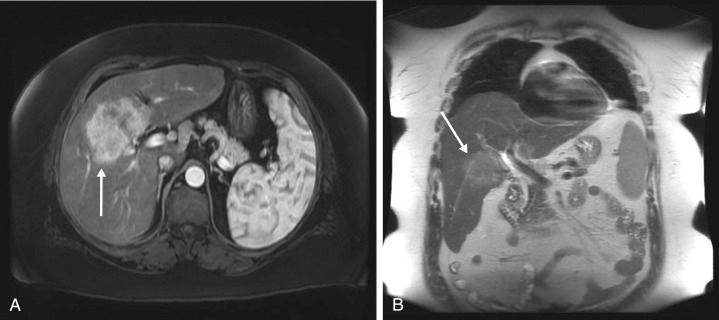
The benign or malignant nature of liver lesions can be determined by imaging, and therefore pathological confirmation is not mandatory. Despite some variability, certain tumor features, if present, can lead to strong suspicion of malignancy, such as a solid, round lesion with enhancement denoting rich arterial supply. Margins of malignant lesions are usually irregular from compression of adjacent tissue, thus resulting in localized edema and somewhat feathery or indistinct contour ( Fig. 16-2 ). When abutting the liver capsule, they can cause retraction and thus liver contour deformity. Vascular invasion by tumors is found as intrinsic occlusion of portal vein branches more often than by extrinsic compression.
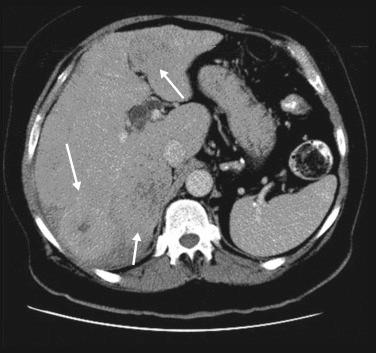
Primary biliary malignancy (cholangiocarcinoma [CCA]) localized centrally in the liver can be very difficult to diagnose based on imaging. These tumors are frequently similar in imaging characteristics to the surrounding hepatic tissue: isoechoic on sonography, isodense on CT, isointense on MRI scanning ( Figs. 16-3 and 16-4 ). Hilar adenopathy can raise suspicion, although it can be present in underlying primary sclerosing cholangitis (PSC). Peripheral CCAs have a more typical appearance, with brisk arterial contrast enhancement on CT and high signal intensity on T2-weighted MRI scans.

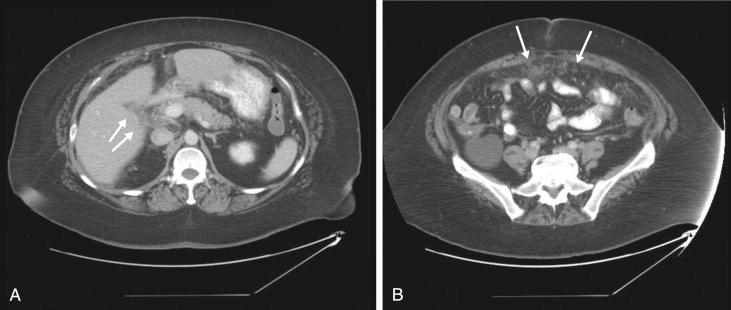
Some of the liver tumors identified on imaging have clear-cut features of benign processes, such as cavernous hemangiomas, focal nodular hyperplasia, hepatic cysts, and focal fatty infiltration ( Fig. 16-5 ). They can occasionally mimic malignant processes, and therefore they need careful assessment for typical benign features ( Fig. 16-6 ).
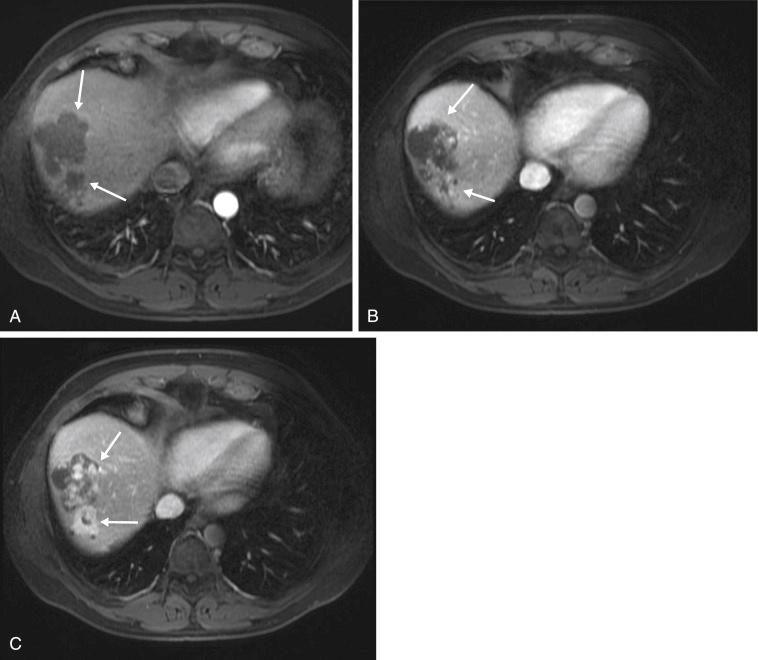
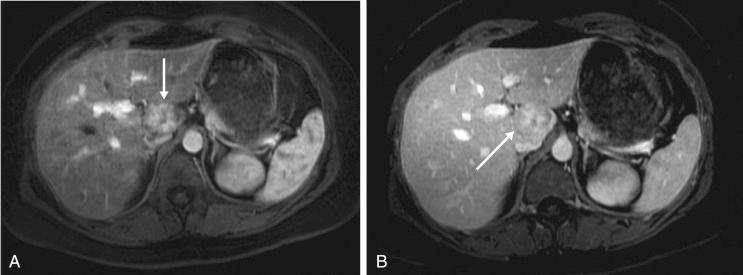
A complete evaluation of liver tumors requires characterization of the nontumor liver tissue, a search for additional tumor nodules, and extrahepatic spread with abdominal adenopathy and metastases (lung, bone). Positive emission tomography (PET) scanning is helpful in differentiating metastases from benign processes.
The evaluation of hepatic masses requires a multidisciplinary approach—because characterization of liver masses dictates both the therapeutic approach and the follow-up imaging modality and frequency.
The majority of the malignant lesions of the liver in the United States are metastatic in origin. HCC accounts for 80% to 90% of the primary malignancies, whereas CCA constitutes most of the rest. Some of the tumors exhibit mixed features of HCC and CCA. Most patients with HCC in the Western Hemisphere (70% to 90%) have some degree of cirrhosis. In Asia and West Africa, HCC occurs frequently in normal liver tissue. The incidence rate in these areas is 30 cases per 100,000 population. HCC is the fifth most common malignancy worldwide, with more than a million new cases a year. It ranks as the third most fatal tumor worldwide. The incidence of HCC more than doubled in the United States in the last decades : it rose from 1.6 cases per 100,000 population in 1975 to 4.9 per 100,000 in 2005. The case-fatality ratio is 0.8, and the median survival is less than 6 months in most cases.
In the United States, HCC is more prevalent in Asians and American Indians, followed by African Americans, and whites. HCC is three times more frequent in men compared to women. Patients with established cirrhosis have an annual HCC incidence of 3% to 10% depending on the underlying liver disease. Chronic inflammation in the liver leads to necrosis followed by increased regeneration, which can lead to a higher rate of cell mutation and hence carcinogenesis. The hepatitis B virus can also act directly with disruption of the hepatocyte DNA followed by faulty repair. HCC can also occur via the pathway of adenomatous hyperplasia, which can lead to malignant transformation. These changes are associated with marked alteration of the apoptosis-to-mitosis ratio.
In Asia the incidence of HCC correlates with that of hepatitis B, whereas the most frequent cause of HCC in the West is hepatitis C (HCV). The risk of HCC seems to be maximal 30 years after infection with HCV. There is an increase in the incidence of HCC parallel to the rise of HCV, which is expected to peak in 2025. In Western countries, the United States in particular, the obesity epidemic leads to an increase in the incidence of nonalcoholic steatohepatitis, which if uncontrolled, will be the leading cause of cirrhosis and HCC. Hemochromatosis, although relatively rare in the population, carries a 45% risk of HCC. Genetic abnormalities, such as chromosome aberrations or gene mutations, have been described with HCC, but a unifying genetic/molecular mechanism was not characterized. Other risk factors for HCC include aflatoxin, azo dyes, aromatic amines, N -nitroso compounds, chlorinated hydrocarbons, hydrosol compounds, pesticides, radiation, thorotrast, smoking, porphyria, Budd-Chiari syndrome, oral contraceptives, anabolic steroids, and α 1 -antitripsin deficiency. HCC is less common in patients with autoimmune hepatitis, Wilson's disease, and alcohol-induced cirrhosis.
In patients with known chronic hepatitis, most cases of HCC are found by screening imaging. Unfortunately, HCC tumors become symptomatic when already in an advanced stage. Some patients may present with diffuse or localized abdominal pain, sometimes radiating to the right shoulder, postprandial fullness, or jaundice. Others present with a palpable mass or deterioration of liver function. Sudden abdominal enlargement is an ominous sign, as it can be related to portal vein thrombosis or tumor bleeding. Patients typically display symptoms of chronic liver disease, with splenomegaly, ascites, and jaundice. Some patients have paraneoplastic syndromes, with polycythemia, polymyositis, deep vein thrombosis, hypoglycemia, and chronic diarrhea.
Serum α-fetoprotein (AFP) level is a useful marker when elevated, especially if above 400 ng/mL, and 70% of patients have elevated AFP level. Des-gamma-carboxy prothrombin level is similarly useful when elevated ; however, it has not gained widespread use. Further diagnosis is made with imaging. Ultrasonography is mostly a screening tool for the diagnosis of HCC. Contrast-enhanced sonograms (with liquid microspheres) increase the sensitivity for HCC ; the procedure is not available in most countries. A more complete assessment of tumor size, characteristics, and tumor burden is made with multiphasic contrast CT scanning or MRI scan. Most tumors have the characteristic arterial blush. In this situation the suspicion of HCC is very strong. CT or MRI provides complete imaging of the liver. Both CT and MRI scans have good sensitivity and specificity. In a systematic review of studies where imaging was compared with pathological characteristics of explants, the sensitivity of imaging increased from 60.5% for sonograms, to 67.5% for CT, and 80.6% for MRI, whereas the specificity decreased from 96.9% (sonogram), to 92.5% (CT), and 84.8% (MRI). Although PET scans may predict microvascular invasion, they are rarely used in practice.
At times it is difficult to differentiate benign nodules in the cirrhotic liver from HCC, or focal nodular hyperplasia can mimic malignancy. In this situation a tumor biopsy is warranted. Tumor biopsy had excellent sensitivity and specificity, except for small nodules ; 2% to 11% of specimens are inadequate. Routine biopsy of lesions suspicious for HCC has been discouraged. Because HCC is a well-vascularized tumor, there is a higher risk of bleeding than with liver biopsy. There is also a 1% to 5.1% risk of parietal tumor seeding, which results in metastasis, with a median occurrence of 17 months, and most metastases are hard to treat. Currently the diagnosis of HCC can be made using two different imaging modalities or one imaging modality and elevated AFP level. Diagnosing HCC without a biopsy comes at the expense of false-positive results (e.g., no tumor in the pathological examination of the explant).
When performed, a tumor biopsy can diagnose poorly differentiated tumors or vascular invasion, in which case a liver transplant is contraindicated. However, tumors, especially large ones, are heterogenous, and at times tumor differentiation can be overestimated, and vascular invasion is missed. Certain tumors require differentiation from CCA or metastatic tumors, typically with additional staining for AFP, carcinoembryonic antigen, CD10, and CD15.
Imaging for extrahepatic staging of HCC include CT scan of chest, abdomen, and pelvis, and bone scan ( Fig. 16-7 ).
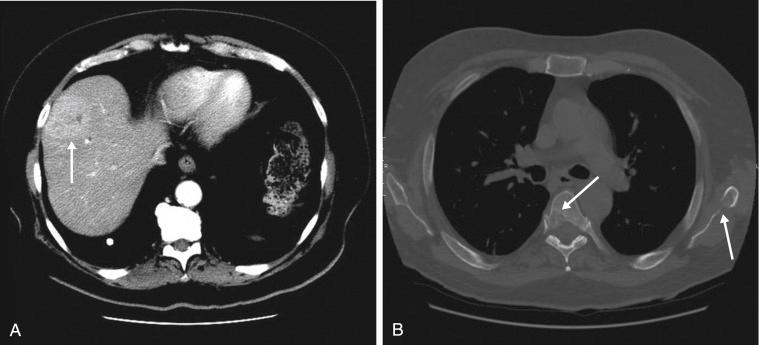
Multiple staging systems were adopted for HCC, whether strictly oncological or prognostic or combined. The TNM system, based on tumor size and number (T), lymph node involvement (N), and the presence or absence of metastasis (M) has undergone a few revisions; the most recent version is shown in Table 16-1 . Liver transplantation mostly benefits patients with stage I or II tumors, although some transplants are performed for some stage IIIA patients using expanded tumor inclusion criteria. The TNM system has limitations, because the data used in decision making are based on imaging and not actual histological results, and imaging can underestimate tumor burden in stage II patients by 27% to 33%. The severity of the background liver disease, an important part of prognosis, is not part of TNM. TNM staging does not correlate with posttransplant survival.
| T1 | Solitary tumor without vascular invasion |
| T2 | Solitary tumor with vascular invasion or multiple tumors none more than 5 cm |
| T3 | Multiple tumors more than 5 cm or tumor involving a major branch of the portal or hepatic vein(s) |
| T4 | Tumor(s) with direct invasion of adjacent organs other than the gallbladder or with perforation of visceral peritoneum |
| N0 | Indicates no nodal involvement |
| N1 | Indicates regional nodal involvement |
| M0 | Indicates no distant metastasis |
| M1 | Indicates metastasis presence beyond the liver |
| Stage Grouping | |
| Stage I | T1 + N0 + M0 |
| Stage II | T2 + N0 + M0 |
| Stage IIIA | T3 + N0 + M0 |
| Stage IIIB | T4 + N0 + M0 |
| Stage IIIC | TX + N1 + M0 |
| Stage IVB | TX + NX + M1 |
To better evaluate prognosis, several groups have proposed staging systems that include both pathological and functional criteria. The Okuda staging system ( Table 16-2 ) combines tumor size with serum bilirubin level, albumin level, and ascites. The Cancer of the Liver Italian Program (CLIP) score combines tumor morphological characteristics, Child-Turcotte-Pugh (CTP) score, portal vein thrombosis, and AFP levels, with severity ranging from 0 to 6 ( Table 16-3 ).
| Criteria | Positive | Negative |
|---|---|---|
| Tumor size ∗ | >50% | <50% |
| Ascites | Clinically detectable | Clinically absent |
| Albumin level | <3 mg/dL | >3 mg/dL |
| Bilirubin level | >3 mg/dL | <3 mg/dL |
| Stage | ||
| I | No positive | |
| II | One or two positives | |
| III | Three or four positives | |
| Variable | Score |
|---|---|
| Child-Turcotte-Pugh class | |
| A | 0 |
| B | 1 |
| C | 2 |
| Tumor Morphological Characteristics | |
| Uninodular and extension ≤ 50% | 0 |
| Multinodular and extension ≤ 50% | 1 |
| Massive or extension > 50% | 2 |
| α-Fetoprotein | |
| <400 ng/mL | 0 |
| ≥400 ng/mL | 1 |
| Portal Vein Thrombosis | |
| No | 0 |
| Yes | 1 |
Although considered a staging system, the Barcelona Clinic Liver Cancer (BCLC) classification is a treatment algorithm and not a pure staging tool. It combines the Okuda staging with the CTP score, number and size of nodules, portal vein thrombosis, and functional status to recommend treatment modalities ( Fig. 16-8 ).
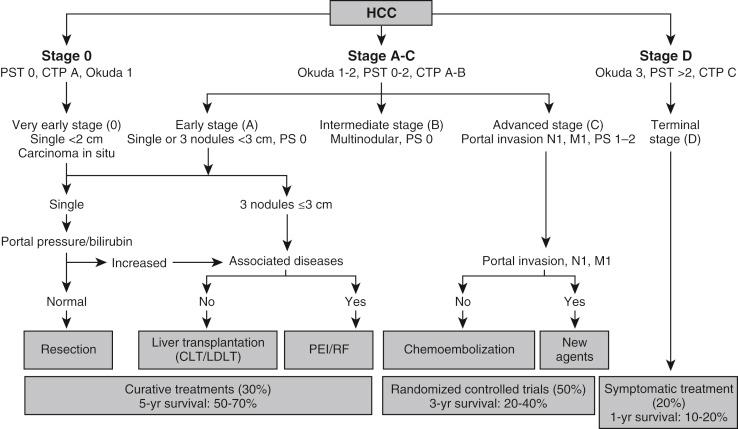
Because most of the HCC tumors arise in the setting of chronic liver disease with or without cirrhosis, the prognosis of HCC is dictated not only by the tumor biological properties and progression, but also by the severity and evolution of the underlying liver disease. Adverse tumor factors have been studied extensively. Adverse tumor factors include tumor size, number of nodules, poor tumor differentiation, vascular invasion, nodal or extrahepatic involvement, and portal vein thrombosis. Portal vein thrombosis due to HCC is a contraindication and needs to be differentiated from bland portal vein thrombi. Poor tumor differentiation and vascular invasion are strong determinants of poor oncological outcome. Unfortunately, vascular invasion cannot be diagnosed with the current imaging or laboratory tests available. Pathological data are seldom available before transplant, and a tumor biopsy sample can miss vascular invasion. Vascular invasion is the strongest predictor of poor outcome, and it correlates with tumor size and number of nodules. Tumors greater than 5 cm in diameter, a larger number of nodules, and high AFP level are associated with poorer differentiation and a higher likelihood of vascular invasion. AFP values greater than 400 ng/mL and 1000 ng/mL are associated with poor outcome in group comparison, but not for every patient. High levels of des-gamma-carboxy prothrombin (protein induced by vitamin K antagonist II [PIVKA-II]) are associated with worse posttransplant outcomes. Fast tumor progression typically denotes poor tumor biological properties and is associated with high recurrence rate and mortality after transplantation.
Become a Clinical Tree membership for Full access and enjoy Unlimited articles
If you are a member. Log in here